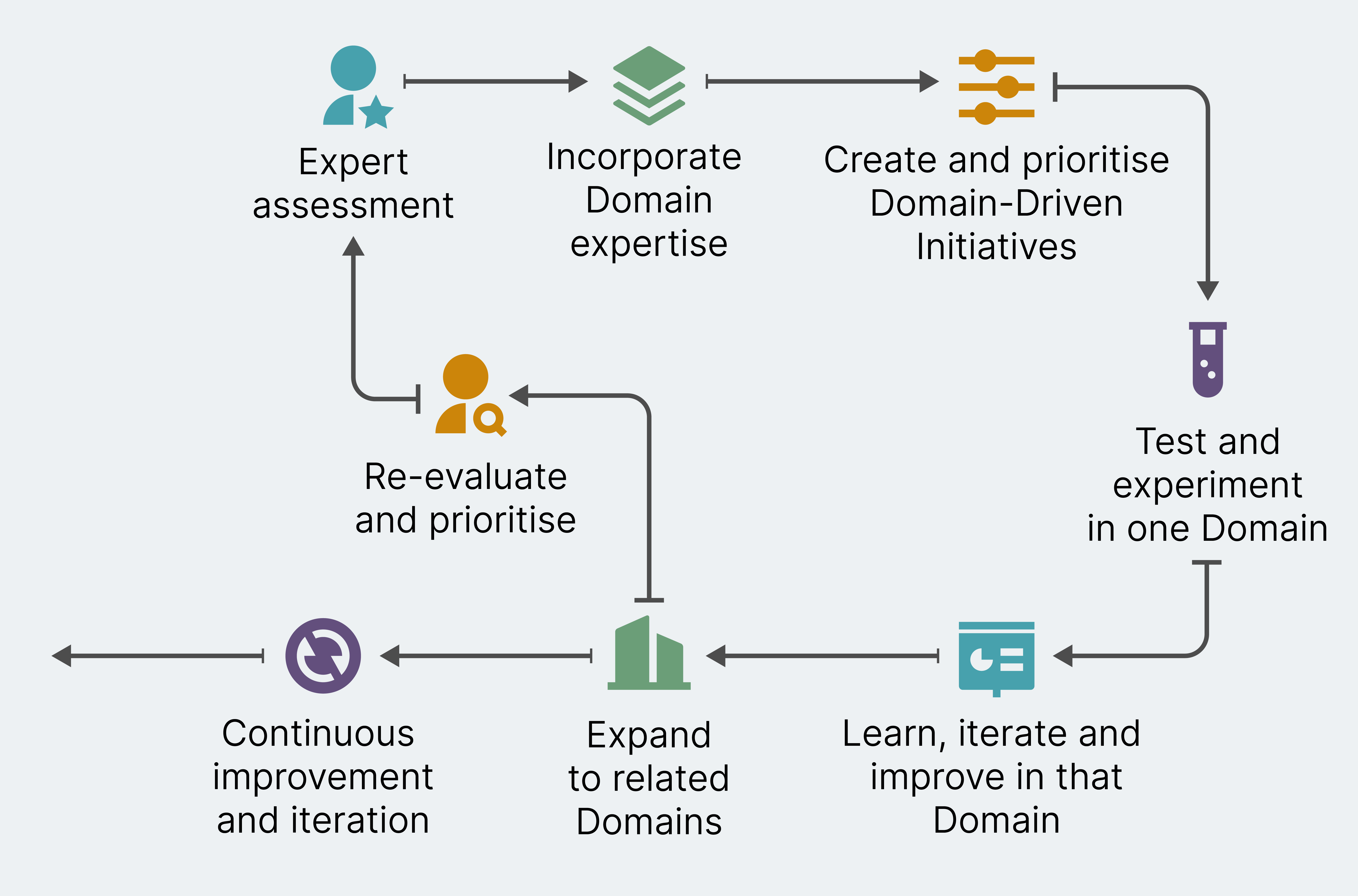Designing out of difficult times

Uniquely challenging times call for unique approaches, not the standard
playbook. Design offers this fresh perspective. McKinsey research has shown that
companies that embrace the business value of design are better able to respond
to shifting landscapes and generate improved performance. From 2013 to 2018,
these companies had TSR that were 56 percentage points higher than that of their
peers.3 In addition, companies that continued or increased their investment in
innovation during the 2008–09 recession generated three times more growth
compared with their industry peers in the three to five years that followed—in
many cases leapfrogging their competitors.4 These results make sense given that
a recession doesn’t mean that markets and customer needs suddenly stop evolving.
In fact, such evolutions often speed up. For these reasons, we believe design
should join topics such as finance, strategy, and talent on the CEO’s agenda. In
this article, we explore specific examples where design has the potential to
create significant value and boost an organization’s resilience. Executives can
use the design function to unleash the power of creativity in strategy and
problem solving in at least five important areas (exhibit).
Microsoft’s Distributed Application Framework Orleans Reaches Version 7
In Orleans, the desired distributed functionality is modelled as a grain, an
addressable unit of execution that can send and receive messages to other grains
and maintain its own state if necessary. The grains are virtual actors,
persisted to durable storage and activated in memory on demand, in the same
sense as virtual memory is an abstraction over a computer's physical memory. The
grains had to inherit from the Grain base class in the previous versions of
Orleans. Now the grains can be POCO objects. To get access to the code
previously available only inside the Grain class, they can now implement the
IGrainBase interface instead. The Orleans runtime keeps track of the
activation/deactivation and finding/invoking grains as necessary. It also keeps
clusters of silos, the containers for the execution of grains. The communication
with the Orleans runtime is done using the client library. The last Orleans
major version before 7.0 was version 3.0, released in 2019. The planned 4.0
release was later ported to .NET 7 and renamed to 7.0 to match the broader .NET
7 ecosystem launches.
Collaboration on IoT could transform risk and insurance

IoT offers an opportunity to fundamentally transform the insurance and risk
management proposition in the large commercial space, to the mutual benefit of
both customers and carriers. Networks of partnerships and IoT ecosystems will
enable insurers to bundle technology, risk management services and risk
transfer, while the flow of real-time risk data and insights would pave the way
for a range of new and innovative solutions. However, these benefits can only be
fully realised when IoT is installed in close collaboration with risk management
and other business functions that stand to benefit or that would be impacted.
Risk managers and risk experts play a vital role in transforming IoT data into a
meaningful tool, and are ideally positioned to facilitate these discussions with
internal stakeholders, as well as insurers. We are only at the start of this
exciting journey, but collaboration will be critical for understanding customer
needs and creating new solutions.
4 Steps to Help Organizations Embrace Risk from Emerging Technology
Particularly as companies invest in emerging technologies, business leaders need
to listen more to their risk and compliance functions and integrate them into
conversations about how those technologies will be implemented. Artificial
intelligence is a great example: when companies rush to implement systems to
accelerate efficiency and analyze trends, they risk creating disproportionate
bias and violating personal privacy through data sourcing. Risk professionals
need to be at the table from beginning to end to make sure that an evolving
regulatory environment and other pitfalls are fully accounted for in the
organization’s implementation process. While investment in risk management
technology is helpful, it is insufficient without making structural changes to
the organization to prioritize the risk function company-wide. ... When adopted
purposefully, emerging technologies can make companies more efficient, more
profitable, and better stewards for their employees, clients and communities.
Risk is often unavoidable for early adopters of emerging technologies, but it
can be mitigated if C-suites equip their risk functions with a holistic strategy
and a voice in key business decisions.
EU fails to protect human rights in surveillance tech transfers

In its decision, the Ombudsman said that, having examined the documentation
surrounding several EUTFA projects, there was no indication that proper human
rights impact assessments were carried out. “The Ombudsman has identified
shortcomings in that the Commission was not able to demonstrate that the
measures in place ensured a coherent and structured approach to assessing the
human rights impacts of EUTFA projects,” it said. “The Ombudsman finds it
regrettable that the EUTFA projects in question were not subject to a clear
human rights impact assessment, presented either as separate document or a
separate section in the action documents. It further noted, for example, that
despite the EUTFA projects covered by its inquiry being implemented in countries
with major governance issues and poor human rights records, the analysis
conducted by the Commission focused more on logistical issues, and that any
assessments of the human rights impacts were “sporadic and unstructured” at
best. It added that while the Commission itself considers the measures in place
– including its multilayer approval process of projects; the use of specific
“action” documentation for projects; and the possible suspension of funds – to
be sufficient in safeguarding human rights, “the Ombudsman disagrees”.
Defining a Data-Driven Culture to Turn Uncertainty into Possibility
The limiting factor often lies in the design of organizational structures,
especially in those focused on executing or exploiting current business
models. The ultra-focus on efficiency here may lead to leaders stifling key
impulses that lead to change such as seeking new data or exploring new
possibilities that are also inherently a basic human attribute. Recognizing
this need for change in uncertain environments is a critical first step and a
strong data-driven culture values and promotes curiosity among its employees,
and fosters creativity as an outcome to turn uncertainty into possibility.
Nathan Furr, a celebrated author and professor at Institut Européen
d’Administration des Affaires (INSEAD) has studied uncertainty based on
interviews and observations across world-renowned leaders, innovators, and
entrepreneurs. His studies provide strong evidence that leaders can be trained
to face uncertainty and as result, discover new sources of revenue not seen
before. You need to start by asking how your industry must evolve to meet the
challenges of new technologies.
Is the Hassle of Sharing Data Worth the Value it Creates?

When deciding whether to address customer demands that require collection, use
and sharing of their personal data, D&A leaders must consider the balance
of economic and consumer value. Too often, a focus on regulations and legalese
gets in the way of this conversation. Legal discussions about data-driven
initiatives are often constrained by risk avoidance mindsets, which limits
business impact and value. To prioritize business outcomes, executive leaders
must focus data collection and monetization discussions on revenue generation,
cost savings, and balanced risk mitigation. Start data sharing and
monetization efforts by identifying known desired business outcomes, as well
as unknown opportunities, for quantifiable economic benefit. Organizations can
expend sizable investments for personal data rights, including the right to
use/reuse and share/reshare data, but not all rights procured will match your
business case, be relevant to consumer demand, or even be enforceable,
resulting in economic waste. Invest resources to obtain legal rights to
locate, use and share the “right” data to match your targeted monetization use
case.
Privacy-first data via data mesh: migrating governance to federated delegation

As you are building organizational co-ownership and shared responsibility via
federation, you also need to design systems that allow for federated design,
development and use. This means pushing your architects to think about data
governance in a federated manner, which might be new for them! For privacy
experts at your organization, this means working closely with your information
security and technical counterparts. How can we implement the privacy goals
set by the organization in our architecture and software? How does our
architecture design support privacy first? You may need to spend time
exchanging knowledge to get to a place where this conversation can happen more
fluidly and in the same language. If technical leaders at your organization
haven’t already heard about Privacy Engineering — this is a great place for
them to start learning the current technologies, processes, design and theory
around incorporating privacy in a technical environment.
Stakeholders want more than AI Bill of Rights guidance

The AI Bill of Rights offers guidance and resources to businesses, but is not
an enforceable law, meaning businesses and federal agencies don't need to
comply with the ethical AI principles it lays out, Engler said. Instead, the
AI Bill of Rights catalyzes federal agencies to act on the guidance and points
the way for policymakers to consider AI regulation, said Harlan Yu, executive
director of technology and equity nonprofit Upturn, based in Washington, D.C.
"This document in the long term, will be judged not by what's on paper but all
the concrete actions that are going to flow from this document, particularly
from the federal agencies," Yu said during the panel discussion. "We're
talking about prospective rule-making, enforcement actions, regulatory
guidance and legislative actions that really need to put these principles into
practice." The AI Bill of Rights applies to all automated systems that
significantly impact people, such as AI decision-making systems for housing,
employment and healthcare-related decisions, said Sorelle Friedler, OSTP's
assistant director for data and democracy and a panelist.
Does Enterprise Architecture belong in IT?
The belief among the panelists was that EA is a core component in delivering
business value. They all saw themselves as acting on behalf of the business to
support business objectives. I wondered if, perhaps, the reason some EAs
wanted to move to the business was because they believed they would have more
visibility and more purpose there. As if to echo my thoughts, at least one
attendee was not totally confident that shifting to the business would would
have the desired effect. Mats Berglund from Ericsson, wanted to understand why
Enterprise Architects have a “kind of complex” about where they sit. Instead
of asking whether we should report into this or that part of the organization,
he said, “We should be asking ourselves, as EAs, what are we giving the
business?” Mats said it didn't matter that EA was in IT. Enterprise Architects
should continuously prove their value to the business wherever they sit. Their
contribution, after all, is what makes EAs credible advisors to the business.
Returning for a moment to Dominik’s Söhnle’s thesis, he makes the point there
that part of this "IT or the business" tension arises from a lack of business
focus in some of the EA tools on the market.
Quote for the day:
"There is no "one" way to be a perfect
leader, but there are a million ways to be a good one." --
Mark W. Boyer
No comments:
Post a Comment